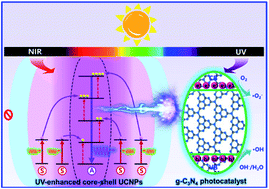Multiphoton ultraviolet upconversion through selectively controllable energy transfer in confined sensitizing sublattices towards improved solar photocatalysis†
Abstract
Multiphoton ultraviolet (UV) upconversion has recently gained remarkable attention because of its promising applications ranging from biomedicine to nanophotonics. However, it is still a challenge to realize intense UV upconversion in conventional lanthanide-doped materials. Herein, we report a mechanistic strategy to achieve the UV upconversion emission by selectively controlling the ionic interactions in a modified core–shell nanostructure through spatial confinement of lanthanide emitters inside a sensitizing lattice. This design ensures the entire surrounding of emitters (e.g., Tm3+, Er3+ and Gd3+) by the sensitizers, which is able to increase the localized excitation energy density and further accelerate the population of intermediate energy levels as well as the higher-lying UV emitting level by sequential energy transfer upconversion processes. 980/808 nm dual-wavelength responsive UV upconversion has also been enabled by incorporating Nd3+ into inert shells. More importantly, the UV upconversion is easily available upon excitation by a commercial 940 nm NIR light-emitting diode (LED), which can be used to expand the spectral response towards improved solar photocatalysis through fabricating a nanocomposite of upconversion nanoparticles/g-C3N4. Our results offer a conceptual model to achieve intense UV emission of lanthanides, showing great promise in frontier fields such as photocatalysis, upconversion lasers, and bioimaging-guided therapeutics.



 Please wait while we load your content...
Please wait while we load your content...